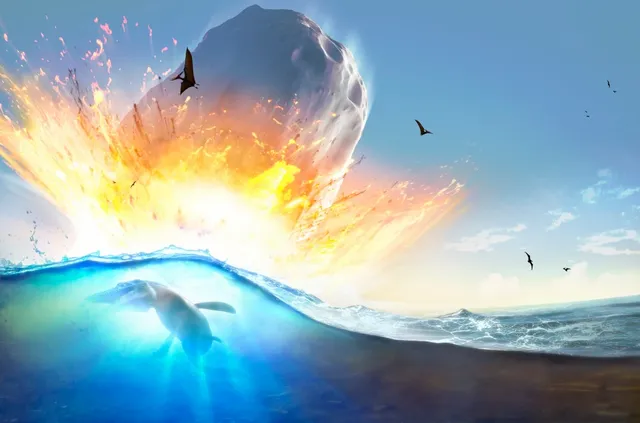Uncovered
TechNews Tech
Try not to LOOK UP! Mankind could keep away from space rock end of the world utilizing nukes, researchers uncover
Onyekachi Nnorom, Deputy Technology and Science Editor
7:30, 8 Feb 2022
Share

IN THE science fiction satire "Don't Look Up", mankind has only a half year to deflect the annihilation of Earth by a 10-kilometer wide space rock.
The film ridicules the worldwide reaction to environmental change, however it brings up the issue: Would we make due on the off chance that we recognized a planet-executioner without a second to spare?
Leo DiCaprio as Dr. Randall Mindy in 'Don't Look Up'
Leo DiCaprio as Dr. Randall Mindy in 'Don't Look Up'Credit: AP
In a new report, researchers at the University of California broke down how humankind may turn annihilation by-space rock.
Very much like the plot of the Netflix hit, they gave their speculative heroes simply a large portion of a year's notification before an effect by a 10km comet.
The group presumed that the best method for endurance would include preparing great many the world's nukes at it - and crossing our fingers.
"Our justification for composing the paper was to inquire: 'Would one be able to forestall a disaster of this nature'," lead creator Philip Lubin, an educator of material science at UC Santa Barbara, told The Sun.
"It's a significant endeavor to check out whether mankind has arrived where we could forestall what befell the dinosaurs 65million years prior."
In the paper, distributed keep going week on the Arxiv information base, Prof. Lubin and an associate initially break down the effect that such a crash would have on Earth.
LUNAR LAP Nasa catches interesting REAL film of Moon passing Earth - and it nearly looks phony
A 10km space rock would probably clear out practically all life on our planet, making the temperature of our environment rocket to 300C.
Given a timescale of quite a long while, Nasa's favored technique to turn away such a disaster includes utilizing a rocket to avoid the approaching item.
In any case, redirecting a stone of planet-killing size with a couple of months' notification essentially wouldn't be imaginable, Prof. Lubin says.
His investigation shows that the main reasonable choice in that situation would be an atomic strike.
"What we bring up is that we effectively have sufficient atomic gadgets to dismantle a huge article like the one in 'Don't Look Up'," Prof. Lubin told The Sun.
"Our atomic armories are intended to basically compromise different countries - yet those equivalent gadgets could be utilized to safeguard us."
The paper proposes that it would be feasible to "dismantle" the item with 1,000 lance formed "penetrators" stacked with atomic warheads - under 10% of the world's present armory.
They could be sent off on one of two profound space rockets as of now being worked on: SpaceX's Starship and Nasa's Space Launch System (SLS).
Both space apparatus are as yet being developed however are because of takeoff on their first spaceflights before very long.
The blasts would strip away layers of the space rock like an onion, breaking it into more modest parts.
There's only one issue: The impacts would prompt the making of radioactive garbage that would then descend upon Earth.
While it's a dismal situation, it's far superior than basically tolerating our destiny because of a colossal space rock, Prof. Lubin says.
"On account of a 10km space rock, you're discussing an existential danger that will kill billions of individuals," he clarified.
"You can say 'in any case, I'm truly stressed over the radiation [created by an atomic safeguard strategy]', yet additionally bite the dust."
Earth's last significant annihilation occasion was the space rock that cleared out the dinosaurs.
It's accepted to have estimated around 12 km across and decimated up to 80 percent of all life on Earth.
From that point forward, our planet has been battered by various more modest, unwanted divine visitors - including the Chelyabinsk meteor.
At only 20 meters wide, the space rock harmed 1,500 individuals and crushed the windows of 7,000 structures when it detonated over focal Russia in 2013.
Prof. Lubin says that, given the recurrence with which the Earth is hit by space rocks, we want procedures set up to manage anything that's tossed at us.
"It's the idea of our regular world that we get hit by comets and space rocks since there are numerous around," he said.
"There are large things out there that, assuming they hit us, it would be devastating.
"Then again, there are a great deal of more modest things out there, some of which are of comparable size to the Chelyabinsk meteor, which are not existential dangers, but rather they might actually kill a many individuals."
Analysts investigated whether mankind could turn away the effect of a space rock the size of the one that cleared out the dinosaurs 65million years prior
Analysts investigated whether mankind could deflect the effect of a space rock the size of the one that cleared out the dinosaurs 65million years agoCredit: Getty
Elsewhere in the world, a four-ton lump of a SpaceX rocket is on an impact course with the Moon, as indicated by online space garbage trackers.
Boeing has sunk $450million into a flying taxi startup that desires to whisk travelers across urban communities before the decade's over.
Customized shrewd firearms, which can be terminated exclusively by confirmed clients, may at long last open up to U.S. buyers this year.
Furthermore, researchers are leaving determined to disentangle the secret behind many shocking kid mummies covered in an underground burial chamber in Sicily.